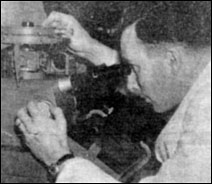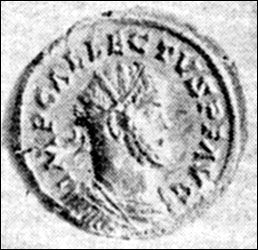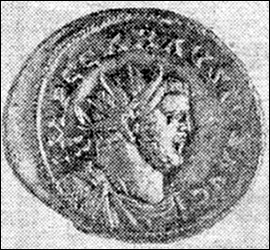|
From BLHS Newsletter - June 2011
The news that further proof of Roman activity in Burton Latimer has been uncovered on the construction site on Higham Road was not entirely unexpected. When Cyril Desborough was digging a silage pit for Mr. W. D. Evans of Hilly Farm in 1954, finds were made that included pottery of the 3rd and 4th centuries, two tesserae, brick, roofing tile, slag and animal bones, together with a hoard of about 120 coins of the late 3rd century and it was concluded that this indicated the existence of a Roman farmstead of some sort on the site. The silage pit was on the far side of the valley of the small stream that now runs below the already developed housing off Higham Road: Cornfield Way and Hollands Drive, but at that time the area was known as Hollands’ Field, which children had used for years as a playground, fishing for tiddlers or making dams in the brook and sledging in the winter.
So far, the new finds consist of three Roman burials, masonry in the form of a wall and other smaller items. Archaeologists from CgMs have started stripping topsoil from the site, owned by David Wilson Homes and Barratt Homes, and the dig is expected to take between two and three months to complete.
In 1967-8, further Romano-British coarse wares, polished samian ware, roofing tiles and flints and Iron Age type hand-made pottery were found during the construction of Churchill Way.
When the Heritage Museum held its “Burton Born or Bred” exhibition five years ago, some of the coins from the Roman hoard were placed on display, together with some of the Iron Age finds from the excavations at the Burton Wold windfarm site. Every effort will be made to arrange for some of these recent finds to be shown in the museum in a new exhibition at a later date.
From: Archaeological sites in Central Northamptonshire – Burton Latimer - HMSO 1979
ROMAN SETTLEMENT AND COIN HOARD (SP 90367445) on the E. side of the valley of a small stream, on sand and limestone at 60 m. above OD. When a silage pit was dug in 1954 finds were made which included pottery of the 3rd and 4th centuries, two tesserae, brick, roofing tile, slag and animal bones, associated with a hoard of about 120 antoniniani of the late 3rd century (Northampton Museum).
IRON AGE AND ROMAN SETTLEMENT (centred SP 895745), lies S.W. of the village on land sloping W. to the R. Ise, on sand at 68 m. above OD. Two Roman coins and some pottery were found some years ago when the area was allotments. During building development in 1967—8 pits and ditches were noted and examination of pipeline and foundation trenches revealed worked flints, cores and hand-made pottery, apparently of Iron Age type. A wide range of Romano-British coarse wares, samian and roofing tiles was also found. Stripping of topsoil for a new road revealed other ditches, dated to the Roman period, clay-lined pits and traces of stone foundations (BNFAS, 4 (1970), 2, 6 and 40).
From the Evening Telegraph December 1954
ROMAN COINS GIVEN TO MUSEUM - HOARD FOUND AT BURTON LATIMER
Northampton Museum in Guildhall-road has been presented with its first hoard of coins. They are Roman ones dug up near Burton. Latimer during the summer by Mr. W. D. Evans, of Hilly Farm, High-street, Burton Latimer. The hoard is the first to be dug up in the County for a long time. Most of the coins are in a very good state of preservation. They were minted at London and Colchester, and the mint marks still show quite clearly on many of them.The earliest of the coins is that bearing the head of Victorinus who reigned from 265-267 A.D. It is thought that they were buried towards the .end of the third century. The coins are bronze with a silver wash, and the fact that many still have the silver on them adds extra value to the find. It is most unusual to find coins with the silver still on them, as the wash, used to make production cheaper, was very thin. An idea of their original value can be gained from the fact that 12½ of these coins would be the normal monthly, pay of an ordinary Roman soldier. The museum has a total of 108 coins.
|
From the Kettering Leader & Guardian & Northamptonshire Advertiser, Friday Nov. 4. 1955
ROMANS FOUND A WAY TO DISGUISE COINS: SECRET IS DISCLOSED
Experts were intrigued when they examined a hoard of 108 Roman coins found buried in a field at Burton Latimer last year. For some of the 1,600-year-old coins showed distinct traces of thin silver wash on their surfaces. How did the silver get there, since the Romans for, all their accomplishments, had no knowledge of electroplating?
In an attempt to find the answer Mr. L.H.Cope, a keen numismatist, has been enlisting the aid of some of the modern apparatus at Corby Technical College, where he a lecturer on metallurgy. After a number of experiments he believes he may have hit upon the method used by the Romans.
He mixed silver ore with a strong brine, and he found that if a coin was dropped in, and at the same time given contact with an iron surface, an electrolytic cell was set up sufficient to produce a silver coating.
“So far I have managed to make only a soft coating that wears off quickly,” he said. “But it is possible the Romans may have hit on something like this, since the materials necessary were easily obtainable at that time.” Mr. Cope, whose home is at “East View”, New Road, Geddington, was elected a Fellow of the Royal Numismatic Society a fortnight ago, largely because of his research into ancient coins. He was given permission to experiment with the Burton Latimer hoard – found on the farm of Mr. W.D. Evans – by Mr. Alan Warhurst, curator of Northampton Museum.
First job was to get rid of the thick coating of verdigris. This he accomplished, after several experiment, by using ordinary household ammonia. Before examination a coin was polished to a mirror finish, then etched with acids to show up the structure more clearly.
 |
Finally, Mr. Cope made use of the College’s £1,000 photo-micrography equipment, used in advances metallurgy studies, which was capable of giving up to 2,000 magnification. The photographs that resulted showed the structure of the coin in minute detail and gave valuable clues about the methods used in minting. To complete the examination, Mr. Cope destroyed one of the coins to analyse it. How were the coins made? Mr. Cope’s research shows that the small pea shaped blank was placed between two dies and hammered flat. This accounts for the fact that the coins are of different shapes and many different weights. The head on the die was engraved. But each letter was punched in individually, the process being repeated at regular intervals to keep the lettering clean. “Thus each coin is virtually an individual one,” says Mr. Cope. “Modern mass production methods do not lend themselves to the same fineness of detail. |
To read a 1965 article about archealogical discoveries in Burton Latimer by 'Simon Straight' of the Evening Telegraph
Click here
|


